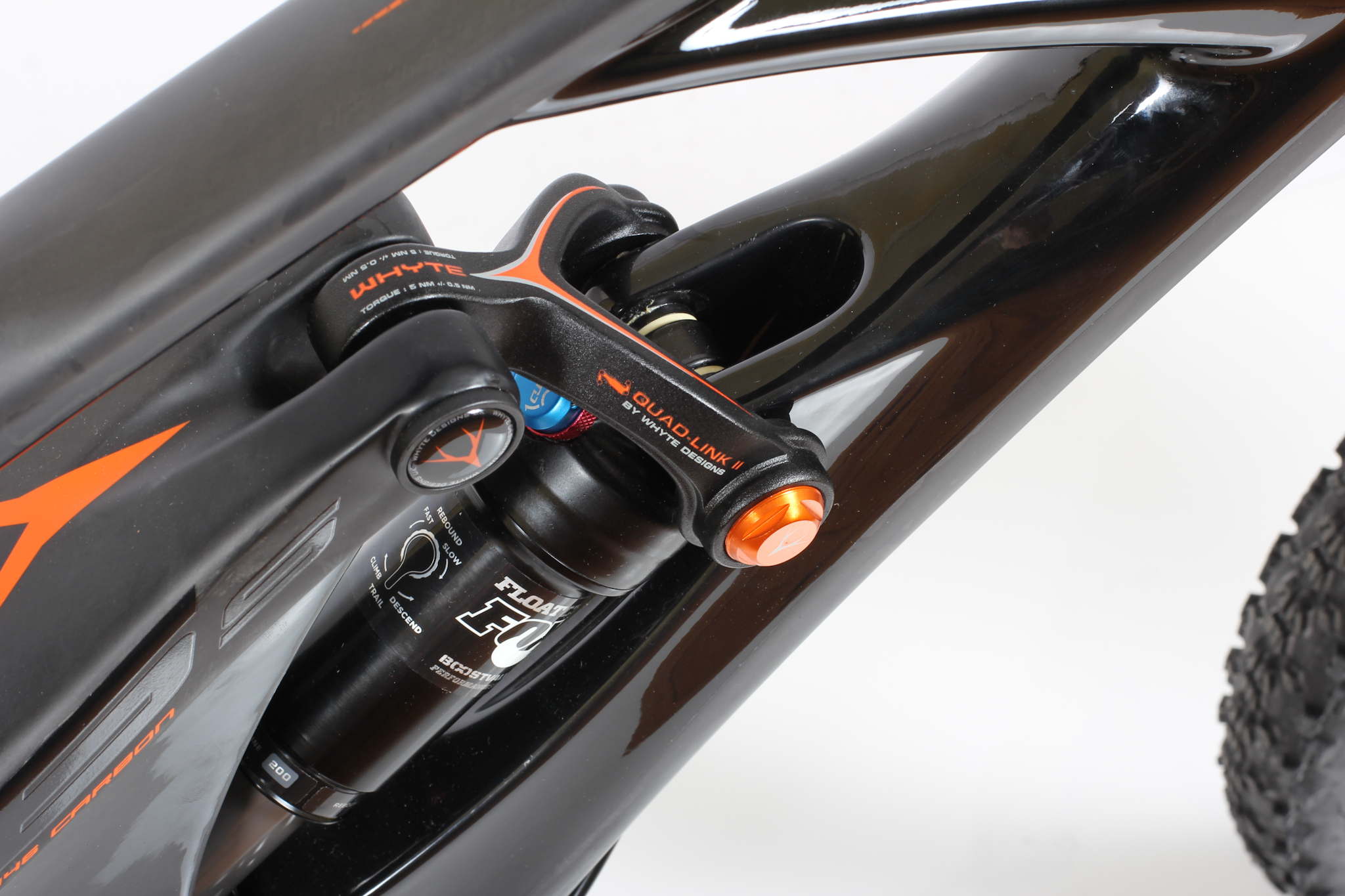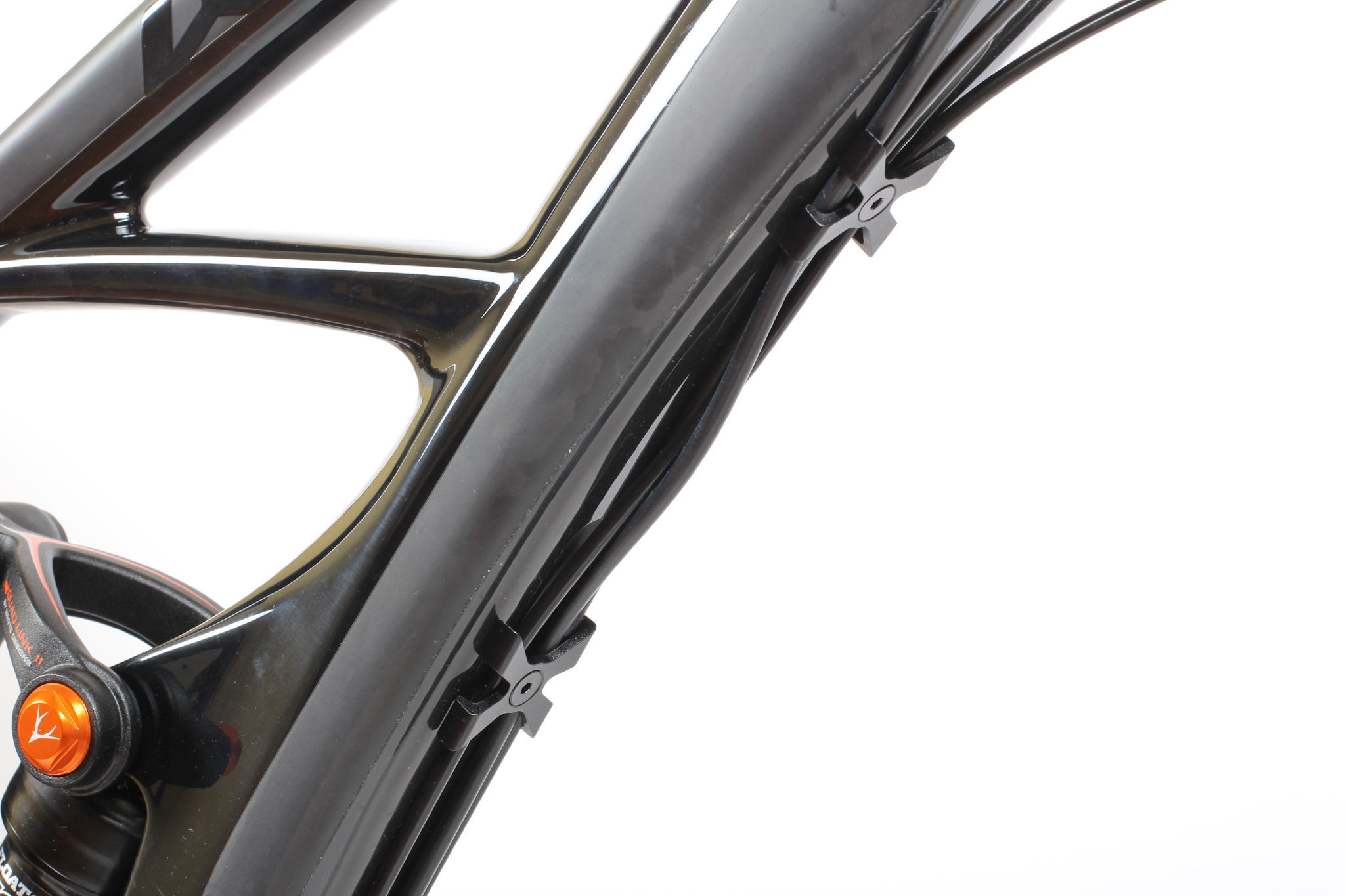Like music, sometimes bikes have to grow on you. You know when you buy that fresh album and the first time you listen to it you’re not 100% sure. But, by the time you’ve onto the fifth rotation you’re in love. That’s how we felt about the Whyte 146 S – it grew on us.
The Whyte 146 S is a 12-kilo-ish, aggressive trail master that loves to turn, and despite its ‘downhill’ appearance and feel it climbs pretty damn well too.

Design and construction:
Straight up the bike looks different. You’re going to either love it or loathe it. There’s a lot of vanilla designs in mountain biking these days and it was refreshing to be riding something pretty different – in both looks and engineering. With the Whyte 146 S, you will stand out amongst the crowd.
The Whyte 146 S is a 26”-wheeled, 150mm travel (146mm rear), full carbon framed, 12.3kg bike designed for all-mountain riding. This aggressive pedigree is conveyed clearly in the bike’s geometry – it has a slack 66-degree head angle and a low and long stance that’s more akin to a downhill bike than your average trail bike. When we first unwrapped this beast we were both excited and full of questions about it.

The most striking visual element of the bike is the suspension design combined with the elevated chain stays. It looks futuristic, like it’s pointing forward. The 146 S uses a 4-bar linkage suspension design, named Quad Link II, with the main pivot point sitting high above the bottom bracket. High pivot designs aren’t all that common; they tend to be more affected by chain-tension forces than other suspension configurations (e.g. pedal feedback when pedalling over rough ground). Executed well, however, a high pivot design can have advantages too; most notably it can give great grip under power, pulling the rear wheel into the ground, and they tend to handle big, square-edged hits very well. The White 146 S fits into the “done well” category and they seem have found a very nice sweet spot with the high pivot.

At first glance it looks like the bike should be top heavy, but the overall weight is so low, that we didn’t notice any imbalance at all. The bike does have extreme geometry, even for an all-mountain machine, but once riding the balance of it all works really well.
The Whyte 146 packs in some other neat frame features that highlight the attention to detail this brand is renowned for. There’s excellent mud clearance and full-length cables – great for the wet weather – and the BB30 bottom bracket keeps the frame weight low. It’s interesting to note that Whyte offer a lifetime warranty on the suspension pivot bearings too; there can’t be many other manufacturers willing to do the same.
The lack of water bottle mounts may annoy some people but this bike isn’t the only one to be missing that ingredient.

The gear:
Being a mid-level bike the spec of the 146 S matches. There are some highlights and interesting points in the package though.
The X9 rear derailleur is a “clutch” type and a nice touch to help keep the chain on. Without chainstays in the normal position slap from noise is even less of an issue. We didn’t lose a chain on our many rides, and if you wanted super security you could add a chain device using the ISCG tabs.
The suspension is excellent, and like all bikes in the all-mountain class, on the fly adjustability is a must. The FOX 34 CTD is a really nice addition to this bike and the extra stiffness of there 34mm legs adds to the overall aggressive characteristics. The fork was super sensitive and buttery smooth and maybe the best out-of-the-box fork we have felt in a long time. Generally we ran the fork in Trail mode on climbs and Descend on the downhills.


We found the choice of a Maxxis Crossmark 2.1 tyre on the rear an interesting option. The 146 S is obviously built for riding downhills fast but running such a narrow tyre would indicate that Whyte were looking to enhance, or improve, the climbing abilities of the 146 S. We did run the 2.1 for a while but it soon got destroyed and a larger tyre was added with no notable impact to the bike’s climbing ability
On the trail:

When we gave our first impressions of the Whyte we made assumptions that the bike should be very stable at pace (due to the long, low, and slack design), but we weren’t so sure about how it would climb. As an executive summary: it was super stable, loved cornering, and climbed pretty damn well – with only a couple of minor drawbacks.
As stated, Whyte seem to have hit the nail on the head with their Quad Link II suspension design, and the bike exudes very strong pedalling traction and climbing grip. We immediately noticed the bike push the rear wheel down (and raise the bottom bracket) as we put in the hard pedals up steep hills – it really digs in, looking for more grip. For a long travel bike it climbs really well and because of these characteristics we never found we had to use the ‘Climb’ mode on the FOX CTD rear shock. The overall low weight helps too, and we’d be happy to take the Whyte on a long cross-country ride.

We guessed that the bike would be very, very stable at speed and would love going fast. We were right. The roomy top tube is combined with a 70mm stem, and the cockpit length felt great. It didn’t feel like a boat on tight corners and the slack head angle never felt like ‘pushing’ through any cornering situation. We were pleasantly surprised on uphill switchbacks as well – the bike has a steep seat angle, so you don’t feel like you’re riding off the back when climbing.
As a package, all the angles and lengths feel great, and of course when the bike is pointed downhills it works best. Looking at that whopping swing arm, initially we were concerned about the suspension blowing too easily through its travel. This wasn’t a worry; the rear suspension has awesome small bump sensitivity but the shock ramps up well towards the end of the stroke to avoid bottoming out. We were able to leave the shock in the Trail mode of the CTD for most situations and only on the big stuff or in loose conditions did we feel the need for Descend mode.

There’s a certain amount of flex in the rear end which we noticed when pushing the bike super hard in corners. For some the flex may be a turn off and for us it generally is too. However, it didn’t seem to effect our overall enjoyment of riding the bike or its cornering abilities. As we stated before, the bike is great through the turns and we can accept that as being a little puzzling for those who swear by super stiff bikes.
Finally, we did feel feedback in the pedals, as per the suspension design. While being noticeable in only limited circumstances it didn’t create any negative performance or overall negative feeling about the bike.
Overall:
We really didn’t know what to expect of the Whyte 146 S. It seemed to have potential to be either very good or be ; turns out it’s very good. It proved to be more than capable on every trail we chucked at it – both down and up. It looks unique and futuristic but that too grew on us too. With such a light frame, you could conceivably turn this bike into have an 11kg trail-smashing, all-mountain machine.
It took a few rotations to love this bike but after a few weeks it was fresh music to our ears.

The test:
Test rider: Damian Breach, our test rider for this review, is 71kg and 172cm tall.
Suspension: 30% rear sag, and around 25% up front.
Tyre pressure: 30psi rear, 28psi front.
Test conducted: Stromlo Forest Park, Canberra
Other notes: We added a dropper post (under-seat lever) and converted the tyres to tubeless. We also had to replace the rear tyre after it was destroyed by a Stromlo rock.